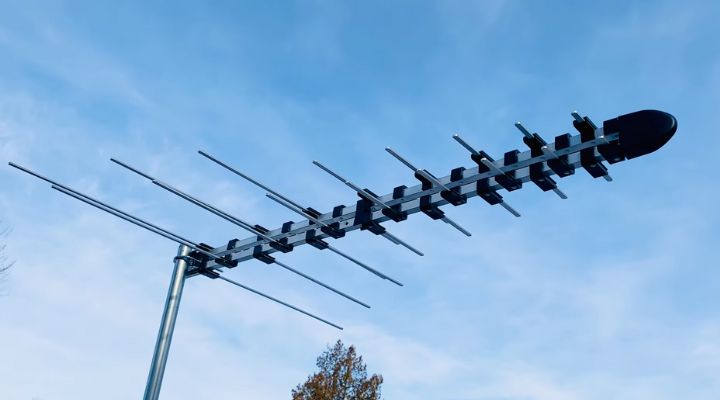The highest TV antenna gain refers to the antenna with the highest ability to receive and amplify television signals, typically ranging from 8 dBi to 20 dBi. A higher gain provides better reception, increased channel availability, and a more stable signal.
High-Gain TV antennas are designed for people living in remote areas or for those who want to receive signals from multiple broadcast towers. These antennas typically have gain levels ranging from 8 dBi to 20 dBi, providing better reception and increased channel availability.
Discover all you need to know about what is the highest TV antenna gain. We’ll delve into the topic of the highest-gain TV antennas and highlight their advantages.
How to Get the Highest TV Antenna Gain?

To get the highest TV antenna gain, there are several factors to consider:
1. Location
The location of your home or building in relation to the broadcast tower is one of the most critical factors in determining the strength of your TV signal. If you live far from the broadcast tower, a high-gain antenna may be necessary to receive the signal.
2. Antenna Type
High-Gain TV antennas are designed to receive signals from a specific direction and amplify them. They are typically directional and have a gain level of 8 dBi to 20 dBi. Other types of TV antennas, such as omnidirectional antennas, do not have as much gain and may not be suitable for areas with weak signals.
3. Frequency Range
The frequency range of the antenna must match the frequency range of the signals you want to receive. Antennas are designed to receive either VHF (very high frequency) or UHF (ultra-high frequency) signals.
Antenna Height
The height of the antenna affects its gain, with higher antennas generally having a greater gain. It is recommended to install the antenna as high as possible and away from obstructions that may interfere with the signal.
5. Antenna Direction
It is essential to point the outdoor antenna in the direction of the broadcast tower to receive the strongest signal. A directional high-Gain antenna should be aimed directly at the broadcast tower for maximum gain.
6. Cable Quality
The quality of the coax cable connecting the antenna to the TV also affects the strength of the signal. It is recommended to use high-quality, low-loss cable to ensure the best possible reception.
Moreover, to get the highest TV antenna gain, you need to consider factors such as location, antenna type, frequency range, height, direction, and cable quality.
Choosing the right antenna and positioning it properly can help you receive the strongest signal and provide clear and stable TV reception.
Factors Affecting TV Antenna Gain
The gain of a TV antenna can be affected by several factors, including:
- Frequency Range
The frequency range of the antenna must match the frequency range of the signals you want to receive. Antennas are designed to receive either VHF (very high frequency) or UHF (ultra-high frequency) signals.
- Antenna Height
The height of the antenna affects its gain, with higher antennas generally having a greater gain. It is recommended to install the antenna as high as possible and away from obstructions that may interfere with the signal.
- Antenna Direction
The direction of the antenna also affects its gain. A directional high-Gain antenna should be aimed directly at the broadcast tower for maximum gain.
- Obstructions
Objects such as buildings, trees, and mountains can obstruct and weaken the TV signal. It is recommended to install the antenna away from obstructions to receive the strongest signal.
- Signal Strength
The strength of the TV signal from the broadcast tower also affects the gain of the antenna. If the signal strength is weak, a high-Gain antenna may be necessary to receive the signal.
Benefits Of Gaining Highest TV Antenna
There are so many benefits of gaining a highest TV antenna. Some of them are:
- Better Reception
A high-gain TV antenna provides better and clearer reception of TV signals, especially in areas where the signal is weak or obstructed.
- Increased Channel Availability
With a higher antenna gain, you can receive a wider range of TV channels, including those from multiple broadcast towers.
- Stable Signal
High- Gain antennas have the ability to receive and amplify signals, providing a more stable and consistent TV signal.
- Cost-Effective
Investing in a high- Gain TV antenna can save you money in the long run as you won’t need to subscribe to cable or satellite TV services.
- Easy Installation
Many high- Gain TV antennas are easy to install, requiring only a few basic tools and no special technical knowledge.
- Environmental Friendly
Using a TV antenna eliminates the need for cable or satellite TV services, reducing the amount of waste and energy consumption.
However, investing in a high- Gain TV antenna can provide a reliable and cost-effective solution for enjoying TV programming.
Conclusion
High-Gain TV antennas are designed for people living in remote areas or for those who want to receive signals from multiple broadcast towers. That’s why you need to know what is the highest TV antenna gain.
But hopefully, you got the answer. These antennas provide better reception, increased channel availability, and a more stable signal. The benefits of investing in a high-Gain TV antenna are many, including cost-effectiveness, easy installation, and environmentally friendly.
Whether you’re in a remote area or just looking for a reliable and cost-effective solution for enjoying TV programming, a high-Gain TV antenna is definitely worth considering.
